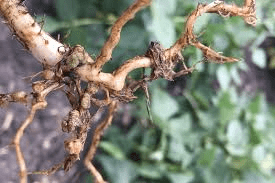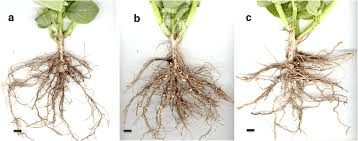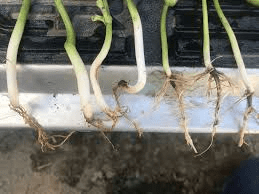Beans roots are a crucial part of the bean plant, serving essential functions such as water and nutrient absorption, anchorage, and storage of food reserves. Understanding the structure and role of bean roots helps in appreciating their importance in the growth and development of the plant.
The root system of a bean plant typically consists of a primary root, secondary roots, and root hairs. The primary root, also known as the taproot, emerges first during germination and grows downward into the soil. It provides strong anchorage for the plant, ensuring stability and support. From the primary root, secondary or lateral roots branch out, increasing the root system’s surface area and enhancing the plant’s ability to absorb water and nutrients from the soil.
Root hairs are tiny, hair-like extensions of the root epidermal cells. They play a significant role in the absorption process by increasing the surface area of the root system. This enhanced surface area allows the plant to take up more water and essential nutrients such as nitrogen, phosphorus, potassium, and various micronutrients. These nutrients are vital for the plant’s growth, development, and overall health.
One of the notable features of bean roots is their ability to form symbiotic relationships with nitrogen-fixing bacteria, particularly those from the genus Rhizobium. These bacteria infect the root hairs and form nodules on the roots. Within these nodules, the bacteria convert atmospheric nitrogen into ammonia, a form of nitrogen that the plant can readily use.
This symbiotic relationship is beneficial for both the plant and the bacteria: the plant receives essential nitrogen, which is often a limiting nutrient in soils, and the bacteria receive carbohydrates and a suitable environment from the plant.
The health of bean roots is critical for the overall well-being of the plant. Healthy roots ensure efficient water and nutrient uptake, which supports robust growth and high yields. However, bean roots can be affected by various pests and diseases, including root-knot nematodes, root rot fungi, and bacterial infections. These issues can lead to poor root health, reduced nutrient and water uptake, stunted growth, and lower yields.
Effective management practices, such as crop rotation, proper irrigation, and the use of disease-resistant varieties, are essential to maintain healthy bean roots.
Bean roots also play a role in soil health. As the roots grow and penetrate the soil, they help to improve soil structure by creating channels that enhance aeration and water infiltration. Additionally, when bean plants are grown as part of a crop rotation system, they can help to improve soil fertility by increasing the organic matter content and fixing nitrogen in the soil through their symbiotic relationship with Rhizobium bacteria.
From an agricultural perspective, understanding bean root development and function is important for optimizing crop management practices. Research into root morphology, nutrient uptake efficiency, and stress responses can inform breeding programs aimed at developing more resilient and productive bean varieties. Sustainable farming practices, such as cover cropping, reduced tillage, and organic fertilization, can further support healthy root systems and overall plant productivity.
bean roots are essential for water and nutrient absorption, anchorage, and food storage. They consist of a primary taproot, secondary roots, and root hairs that enhance their absorption capacity. Bean roots can form symbiotic relationships with nitrogen-fixing bacteria, improving soil fertility and plant nutrition.
Maintaining healthy bean roots is crucial for plant growth and yield, requiring effective pest and disease management and sustainable agricultural practices. Understanding bean roots’ structure and function is key to improving bean crop production and soil health.
The Economic Importance and Uses of Beans Roots

1. Nutrient Absorption: Beans roots absorb water and nutrients from the soil, supporting the growth and development of the plant.
2. Soil Structure: The root system of beans helps improve soil structure by promoting aeration and reducing soil compaction.
3. Crop Rotation: Beans roots contribute to crop rotation strategies, enhancing soil fertility and reducing pest and disease pressure for subsequent crops.
4. Erosion Control: The dense root system of beans helps prevent soil erosion by stabilizing the soil and reducing runoff.
5. Nitrogen Fixation: Some beans, like legumes, have root nodules that host nitrogen-fixing bacteria, improving soil nitrogen levels and benefiting subsequent crops.
6. Cover Crops: Beans roots are used as cover crops to protect soil from erosion, suppress weeds, and add organic matter when tilled back into the soil.
7. Soil Conservation: Beans roots contribute to sustainable agriculture practices by improving soil health and reducing the need for chemical fertilizers.
8. Carbon Sequestration: The biomass of beans roots helps sequester carbon in the soil, mitigating climate change impacts.
9. Livestock Feed: Beans roots can be used as fodder for livestock, providing additional nutrients and organic matter.
10. Bioremediation: Beans roots can be employed in phytoremediation to detoxify contaminated soils by absorbing pollutants.
11. Soil Amendments: Beans roots are used as green manure when incorporated into the soil, enriching it with organic matter and nutrients.
12. Companion Planting: Beans roots benefit neighboring plants by enhancing soil nutrients and promoting biodiversity in agroecosystems.
13. Renewable Resources: Beans roots contribute to sustainable resource management by providing renewable biomass for various agricultural and environmental applications.
14. Land Reclamation: Beans roots are utilized in reclaiming degraded lands, restoring soil fertility, and promoting vegetation growth.
15. Research and Education: Beans roots are studied for their role in soil science, agronomy, and environmental sustainability, contributing to research and educational programs.
16. Traditional Medicine: In some cultures, extracts from beans roots are used in traditional medicine for their therapeutic properties.
17. Biotechnology: Beans roots are studied for their potential in biotechnological applications, such as genetic engineering and biofuel production.
18. Water Conservation: Beans roots enhance water retention in soil, reducing irrigation needs and promoting efficient water use in agriculture.
Read Also: General Features of Ruminant Animals
The Products and By-products That Can Be Derived From Beans Roots

1. Livestock Feed: Beans roots are dried and used as fodder for livestock, providing a source of nutrition and fiber.
2. Herbal Extracts: Extracts from beans roots are used in herbal supplements and medicinal formulations for their health benefits.
3. Bioactive Compounds: Beans roots contain bioactive compounds that are extracted and used in pharmaceutical and nutraceutical industries.
4. Soil Amendments: Beans roots are incorporated into soil as green manure, enriching it with organic matter and nutrients.
5. Compost: Beans roots are composted to create nutrient-rich organic fertilizer for agricultural use.
6. Biodegradable Packaging: Fibers from beans roots can be processed into biodegradable packaging materials, reducing plastic waste.
7. Soil Conditioners: Beans roots improve soil structure and fertility, enhancing crop growth and yield.
8. Erosion Control Mats: Fibers from beans roots are woven into erosion control mats to stabilize slopes and prevent soil erosion.
9. Biogas Production: Beans roots can be used as feedstock for biogas production, generating renewable energy.
10. Biomass Fuel: Dried beans roots are used as biomass fuel for heating and cooking purposes, providing an alternative to fossil fuels.
11. Horticultural Substrates: Beans roots are used in horticulture as substrates for growing plants in containers and hydroponic systems.
12. Water Filtration: Beans roots are used in constructed wetlands and biofilters to improve water quality by filtering pollutants.
13. Landscaping Mulch: Shredded beans roots are used as mulch in landscaping to conserve soil moisture and suppress weed growth.
14. Animal Bedding: Fibers from beans roots are used as bedding material for animals, providing comfort and moisture absorption.
15. Green Roof Systems: Beans roots contribute to green roof systems by improving soil retention and plant growth in urban environments.
16. Textile Fibers: Fibers extracted from beans roots can be spun into textiles and fabrics for various industrial applications.
17. Environmental Restoration: Beans roots are used in ecological restoration projects to stabilize soils and promote vegetation growth in degraded areas.
Read Also: Feeding Materials for Ruminant Animals
Frequently Asked Questions (FAQ’s) About Beans Roots

1. What are beans roots?
Beans roots are the underground part of the bean plant responsible for nutrient absorption and anchoring the plant in the soil.
2. How do beans roots benefit soil health?
Beans roots improve soil structure, enhance nutrient availability, and promote water retention, benefiting overall soil health.
3. Can beans roots be used as livestock feed?
Yes, beans roots can be dried and used as fodder for livestock, providing additional nutrition and organic matter.
4. Are beans roots used in bioremediation?
Yes, beans roots can be used in phytoremediation to detoxify contaminated soils by absorbing pollutants.
5. How do beans roots contribute to sustainable agriculture?
Beans roots contribute to sustainable agriculture by improving soil fertility, reducing erosion, and promoting efficient water use.
6. Are beans roots used in traditional medicine?
Yes, extracts from beans roots are used in some traditional medicine practices for their therapeutic properties.
7. What products can be derived from beans roots?
Products derived from beans roots include livestock feed, herbal extracts, bioactive compounds, compost, and biodegradable packaging materials.
8. Can beans roots be used for energy production?
Yes, beans roots can be used as biomass fuel and feedstock for biogas production, contributing to renewable energy sources.
9. How are beans roots used in horticulture and landscaping?
Beans roots are used in horticulture as substrates and in landscaping as mulch to improve soil conditions and plant growth.
10. What research areas involve beans roots?
Research areas involving beans roots include soil science, agronomy, biotechnology, and environmental sustainability, contributing to agricultural and scientific advancements.
Read Also: Low-Maintenance Plants for Beginners
